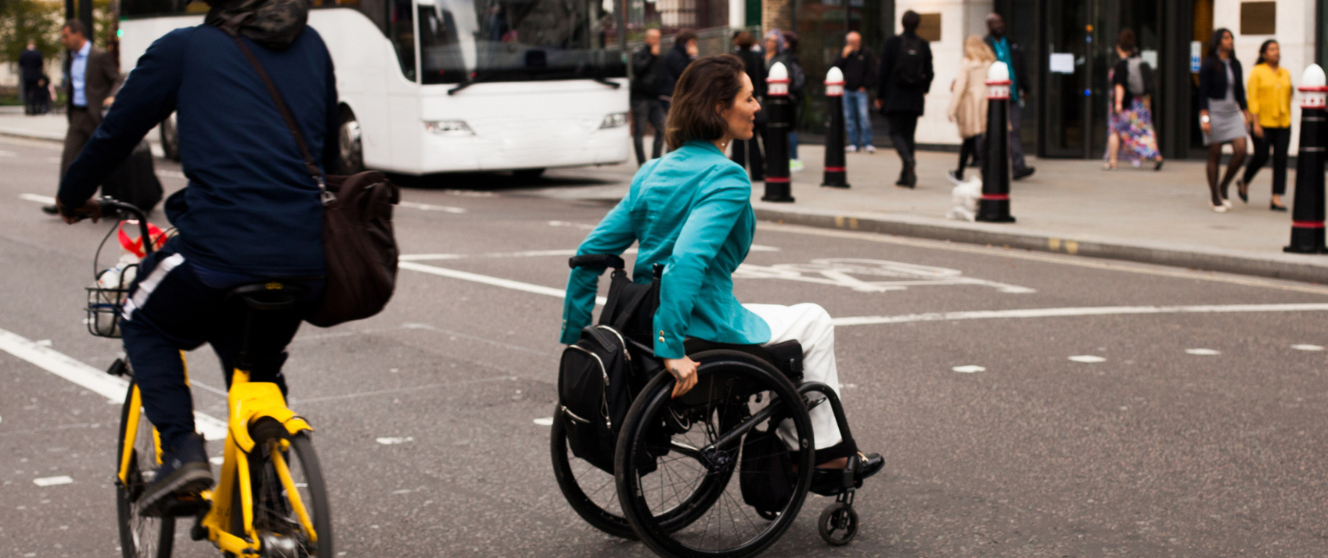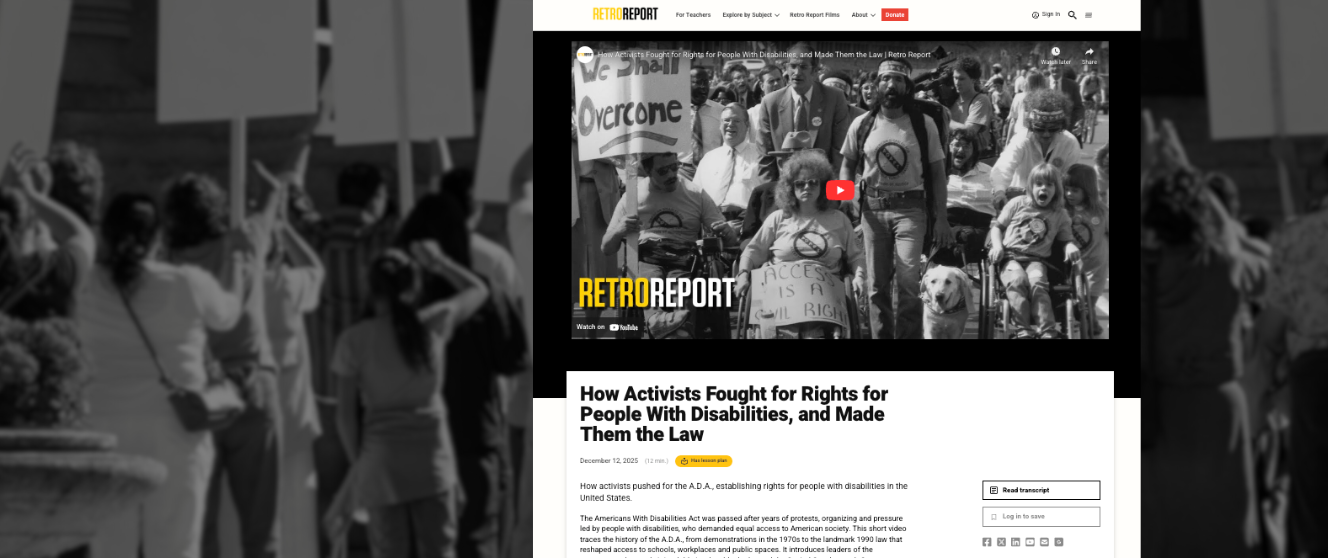
National Council on Disability Meeting
Ground Challenges for People with Mobility Disabilities Autonomous Vehicles Panel
Remarks by Carol Tyson, DREDF Government Affairs Liaison
August 28, 2025
Washington, DC
Thank you for the invitation and opportunity to join you today. It is truly an honor to present before the Council. Thank you for your leadership and thank you to the staff supporting this meeting and the livestream.
Because I live in the District of Columbia (DC), where we are meeting, I need to also acknowledge that DC sits on the ancestral lands of the Nacotchtank or Anocastans and nearby Piscataway and Pamunkey peoples. DC residents are currently being occupied by increased military and law enforcement from around the country. As I travel in my city I often see the Waymo vehicles mapping our streets followed by ICE and other law enforcement, many in unmarked vehicles. My neighbors are being arrested and disappeared, checkpoints are routinely deployed. Please consider learning more about what is taking place here. DREDF has issued a statement and will provide an update with additional actions people can take soon.[1]
DREDF’s Involvement in Autonomous Vehicle (AV) Advocacy
The Disability Rights Education & Defense Fund (DREDF) demonstrated an early interest in the development of AV policy in its drafting of the 2015 National Council on Disability (NCD) report, Self-Driving Cars: Mapping Access to a Technology Revolution,[2] submitted by Marilyn Golden and Susan Henderson, and has participated in Consortium for Constituents with Disabilities (CCD) Transportation Task Force efforts.
In 2022, we published a brief by Ian Moura on Addressing Disability and Ableist Bias in Autonomous Vehicles.[3] We continued the advocacy recommendations from Moura’s brief calling for assurances that AV software can recognize people with disabilities outside the vehicle on the U.S. Department of Transportation’s (USDOT’s) Transforming Transportation Advisory Committee last year.[4] There has been modeling and anecdotes of AV’s speeding up instead of stopping when they encounter a wheelchair user. The AV software is trained to detect people outside the vehicle with sets of data that are often not inclusive of many people with disabilities, including wheelchair users.
Why We All Need to Advocate for Fully Accessible AVs
As we all know, gaining access to transportation has not been easy. The industry fought back against demands for lifts on buses and government stalled, often claiming that lifts were impossible or too expensive, and that separate service for people with disabilities would be cheaper. We know now that access is possible, and separate is neither cheaper nor equal. We have advocated for wheelchair accessible TNCs and taxis for more than a decade.
DREDF believes that the promise and safety of AVs will only be realized if the vehicles and the surrounding infrastructure are fully accessible, and the safety elements consider the needs of all people with disabilities. AV testing and deployment timelines of public and passenger AV companies often fail to mention accessibility, especially wheelchair access.[5] Legislation, both introduced and proposed, has not included accessible vehicle requirements for people with mobility disabilities.
Disability Community Efforts and Legislative Recommendations
In 2023, Congress held a hearing on a “Self-Driving Vehicle Legislation Framework”. Republican and Democrat Representatives submitted CCD Transportation Task Force recommendations from 15 disability rights organizations for the record.[6]
Members of the Task Force urged the Committee to consider essential provisions that would ensure access. These included:
- Explicitly including accessibility and the needs of disabled travelers of all disability types in each USDOT rulemaking related to AVs,
- Ensuring federal law does not prohibit state or local accessibility requirements or performance metrics;
- Ensuring AV-related Americans with Disabilities Act or other civil rights claims can be filed in court;
- Ensuring AVs complement and improve public transit rather than replacing it; and
- Ensuring USDOT and the US Access Board have the resources and staffing to adopt and implement necessary research, rulemaking and standard setting.
Also, currently AV companies can request an exemption from USDOT to deploy their vehicles on streets. Proposed legislation has allowed for additional exemptions based on improving accessibility. Members of the Task Force recommended requiring those exemptions only be provided if the AV fleet includes wheelchair accessible vehicles.
Finally, advocates asked Congress to retain provisions prohibiting discrimination on the basis of disability by states and any other governmental authorities in licensing as well as insurance and the creation of a Highly Automated Vehicles Advisory Council. Credit goes to the National Federation of the Blind and others for advocating early on for prohibition of discrimination in licensing. DREDF has draft legislative accessible AV language that we will work to get introduced in the 119th Congress.
Different Approaches
Finally, I want to note the different needs and strategies that have always existed and been deployed in our broad community – people with sensory disabilities have different access needs than people with mobility disabilities or people with intellectual and developmental disabilities. We talk about competing interests but that often ignores the reality that many members of our community have more than one disability: we can be a wheelchair user who is also low vision.
And while we can have an impact working alongside industry DREDF is concerned that the industry has used the potential for AVs to increase access for all disabled people as merely a talking point. We have seen them pay for research and establish disability advisory councils while not prioritizing deployment of wheelchair accessible vehicles. DREDF has chosen to work with safety, consumer and civil right advocates in drafting and advocating for the AV Tenets Framework as a guide for Congress.[7] We do not believe accessibility will be provided unless it is required. We urge our fellow disability advocates to join us in holding the industry accountable.
[1] Disability Rights Education and Defense Fund (August 14, 2025). DREDF Condemns the Federal takeover of DC, Urges Congress to stand Down the Escalation of Federal Forces. https://dredf.org/dredf-condemns-the-federal-takeover-of-dc-urges-congress-to-stand-down-the-escalation-of-federal-forces/
[2] Golden, Marilyn and Susan Henderson. (November 2022). Self-Driving Cars: Mapping Access to a Technology Revolution. https://www.ncd.gov/report/self-driving-cars-mapping-access-to-a-technology-revolution/
[3] Moura, Ian (November 7, 2022). Addressing Disability and Ableist Bias in Autonomous Vehicles: Ensuring Safety, Equity and Accessibility in Detection, Collision Algorithms and Data Collection. DREDF. https://dredf.org/addressing-disability-and-ableist-bias-in-avs/
[4] US Department of Transportation Transforming Transportation Advisory Committee (December 13, 2024). 2024 Report to USDOT. https://www.transportation.gov/priorities/transformation/transforming-transportation-advisory-committee/TTACReport2024
[5] Hawkins, Andrew (September 2018). Self-driving pods are slow, boring, and weird looking – and that’s a good
thing, The Verge. https://www.theverge.com/2018/9/17/17859112/self-driving-cars-shuttle-podsdelivery-services. Laris, Michael (October 2018). From Model T to driverless: Ford to launch fleet of robot cars in Washington, DC, Washington Post. https://www.washingtonpost.com/local/trafficandcommuting/from-model-t-todriverless-ford-to-launch-fleet-of-robot-cars-in-washington/2018/10/21/6d98119e-d2f6-11e8-b2d2-f397227b43f0_story.html. Sage, Alexandria and Paul Lienert (November 2017). GM plans large-scale launch of self-driving cars in US Cities in 2019. Washington Post. https://www.washingtonpost.com/local/trafficandcommuting/from-model-t-todriverless-ford-to-launch-fleet-of-robot-cars-in-washington/2018/10/21/6d98119e-d2f6-11e8-b2d2-f397227b43f0_story.html. Haddad, CJ. (March 2025). Waymo will launch Washington, D.C., robotaxi service in 2026. CNBC. https://www.cnbc.com/2025/03/25/waymo-will-launch-washington-dc-robotaxi-service-in-2026.html
[6] Consortium for Constituents with Disabilities Transportation Task Force (July 26, 2023). Letter for the House Energy and Commerce Committee hearing on “Self-Driving Vehicle Legislation Framework: Enhancing Safety, Improving Lives and Mobility, and Beating China”. https://www.c-c-d.org/fichiers/CCD-Disability-AV-Framework-Hearing-Letter-072523-FINAL.pdf
[7] Advocates for Highway & Auto Safety (November 2020). Autonomous Vehicle Tenets: A “GPS” to Guarantee Public Safety. https://saferoads.org/autonomous-vehicle-tenets/


